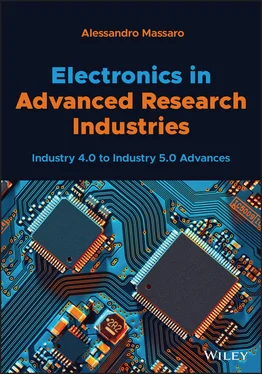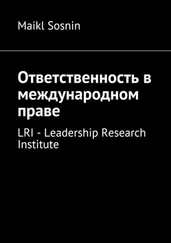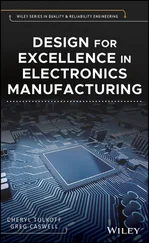8 Chapter 8Table 8.1 RE phases.Table 8.2 Example of workstation characteristics implementing RE facilities ...Table 8.3 Advantages of process simulations in RE.Table 8.4 RE procedure for design optimization of a micrometric optical devi...Table 8.5 Ring and helicoidal MEMS layout versus Mo top layer thickness.Table 8.6 Possible automatisms in RE.
9 Chapter 9Table 9.1 Overview of the main rapid prototyping tools.Table 9.2 Description of UAV elements.Table 9.3 Scheme of the patent.Table 9.4 Scheme of the patent.Table 9.5 Scheme of the patent.
10 Chapter 10Table 10.1 Example of a scheme of the technical proposal.Table 10.1.1 Code of classes or requirements.Table 10.1.2 Use case template scheme.Table 10.1.3 Example of a framework describing technological advantages.Table 10.1.4 Comparison of patent and project facilities.Table 10.1.5 Summary of the tasks assigned to professional units.Table 10.1.6 Example of a training planning.Table 10.1.7 Technology transfer hours for the specific modules.Table 10.1.8 Example of a Gantt diagram.Table 10.1.9 Project milestones.Table 10.2 Example of a business plan.Table 10.2.1 Basic scheme of SWOT analysis.Table 10.2.2 Template of the investment plan.Table 10.2.3 Template of the revenue plan.Table 10.3 Example of a simplified use case table.Table 10.4 Example of a scheme of the business plan.Table 10.5 Example of SWOT analysis for a water leakage detections system.Table 10.6 Project setting approach.Table 10.6.1 Summary of the main partner information.Table 10.6.2 Contact information of the partners involved in the project.Table 10.6.3 Project financial prospect.Table 10.6.4 Relationships between project goals and associated technology.Table 10.6.5 Interactions between actors involved in the project.Table 10.6.6 Example of a testing plan.Table 10.7 Classified results.Table 10.8 Outputs and deliverables related to each work package.Table 10.9 Milestone plan.Table 10.10 Research and development project form.Table 10.11 Model risk example.Table 10.12 Work package typologies.Table 10.13 Description of deliverables.Table 10.14 Milestone definitions.Table 10.15 Modules constituting a generic prototype.Table 10.16 Modules of a generic production line.Table 10.17 Activities of results dissemination.Table 10.18 TRL objectives.Table 10.19 Complementary partners.Table 10.20 NPV and IRR indicators estimated in five years: business plan mo...Table 10.21 Subproject template.Table 10.22 Information report template.Table 10.23 Budget template for work package.Table 10.24 Cost/benefits template.Table 10.25 Risk management template.Table 10.26 Issues template.Table 10.27 Action template.Table 10.28 Deliverable template.Table 10.29 Milestone template.Table 10.30 Work breakdown structure template.Table 10.31 Work breakdown structure weekly structured template.Table 10.32 Contact information template.Table 10.33 Roles and responsibilities template.Table 10.34 Resource assignment template.Table 10.35 Human resource time sheet template.Table 10.36 Constraints template.Table 10.37 Decision template.Table 10.38 Communication plan template.Table 10.39 Stakeholder template.Table 10.40 Opportunities template.Table 10.41 Rule change template.Table 10.42 Deliverable acceptance template.Table 10.43 Pert analysis template.Table 10.44 Delphi template.Table 10.45 Initial project evaluation template.Table 10.46 Human resource loading template.Table 10.47 Project quality metrics template.
1 Chapter 1 Figure 1.1 Example of network configurations: (a) point to point connection;... Figure 1.2 Example of hybrid extended star network and failure system reconf... Figure 1.3 Layers of technologies related to an advanced technology. Figure 1.4 Hierarchical scheme of the software in Industry 5.0. Figure 1.5 Advanced PLC architecture in Industry 5.0: central processing uni... Figure 1.6 Scheme of a pick and place automated system for defect removal, b... Figure 1.7 Image processing and intelligent system in production processes.... Figure 1.8 Interoperability of different technologies involved in Industry 4... Figure 1.9 Information system interconnecting enabling technologies. Figure 1.10 (a) Infrared thermal camera signals. (b) AOV and FOV simplified ... Figure 1.11 Artificial intelligence integrated into the supply chain. Figure 1.12 Multilevel structure of manufacturing industry processes integra... Figure 1.13 Artificial intelligence feedback system in manufacturing process... Figure 1.14 Block diagram of adaptive solutions in advanced manufacturing. Figure 1.15 Scheme of horizontal, vertical and end to end integration in Ind... Figure 1.16 CAD and CNC interconnected by a feedback system. Figure 1.17 (a) Simple ANN. (b) DL neural network. Figure 1.18 (a) Feedback system minimizing calculation error in the training... Figure 1.19 Basic mathematical functions defining activation functions. Figure 1.20 Supervised artificial network model: partitioning of the availab... Figure 1.21 Algorithm classification and Industry 5.0 facilities. Figure 1.22 (a) Regression analysis, (b) data classification, and (c) data c... Figure 1.23 Ensemble method and classification. Figure 1.24 Ensemble method and classification. Figure 1.25 (a) LSTM unit cell. (b) LSTM network and its memory. Figure 1.26 Knowledge gain in industry.
2 Chapter 2 Figure 2.1 Main BPM symbols. Figure 2.2 Main UML symbols. Figure 2.3 Block diagram: digital production process control integrating the... Figure 2.4 Workflow implementing a data mining algorithm with objects (block... Figure 2.5 (a) ROC curve. (b) Threshold criterion. Figure 2.6 Loss function: overfitting and underfitting conditions and perfor... Figure 2.7 Examples of MAE theoretical trends versus neural network paramete... Figure 2.8 (a) Layout controlling silo loading. (b) Implemented workflow of ... Figure 2.9 Feedback system controlling and actuating a load by means of a se... Figure 2.10 Block diagram model of a liquid production system implementing A... Figure 2.11 UML class diagram implementing AI for a PLC system. Figure 2.12 (a) D flip‐flop symbol. (b) Equivalent circuit adopting logic po... Figure 2.13 UML use case diagram of AR technology adopted in kitchen product... Figure 2.14 HoQ diagram matching a laser scanner with AR technologies. Figure 2.15 AI switching production lines for canned food production. The pr... Figure 2.16 Symbols, truth tables, and events characterizing logic ports. A ... Figure 2.17 Equivalent circuits of (a) AND, (b) OR, (c) NOT, (d) NOR, (e) NA... Figure 2.18 (a) McCulloch–Pitts neuron model with binary input b i, weights w Figure 2.19 Infrastructure of predictive maintenance applied to milk pasteur... Figure 2.20 (a) KNIME workflow implementing MLP neural network. (b) MLP neur... Figure 2.21 (a) KNIME network implementing an artificial neural network. (b)... Figure 2.22 Defect chart reading procedure. Unstable regions are provided by...Figure 2.23 Clusters and related centroids.Figure 2.24 Parameters for the estimation of the Euclidean distance.Figure 2.25 Architecture implementing Industry 4.0 and Industry 5.0 faciliti...Figure 2.26 Maintenance plan variation based on prediction results.Figure 2.27 Examples of typical alerting signals relating to the failure con...Figure 2.28 Workflow defining predictive maintenance for pieces in the railw...Figure 2.29 IQ trends: initial curve, real measured curve, and updated curve...Figure 2.30 System architecture: upgrade of a telecardiology network.Figure 2.31 System architecture of a teleoncology platform: functional schem...Figure 2.32 E‐health system architecture of a multipurpose health platform....Figure 2.33 Workflow of combined assistance services.
3 Chapter 3Figure 3.1 Human–machine interface managing multiple mechatronic boards; mod...Figure 3.2 HMIs managing multiple mechatronic boards.Figure 3.3 M2M concept in Industry 5.0.Figure 3.4 Advanced PLC integrated system: feedback system by ANN.Figure 3.5 Standalone decision maker based on an ANN programming PLC system....Figure 3.6 Client–server connection scheme via OPC‐UA protocol (HW, hardware...Figure 3.7 Architecture of a SCADA upgraded system.Figure 3.8 CIM pyramid upgraded by AI.Figure 3.9 Scheme of the connection between the PLC and temperature transduc...Figure 3.10 (a) EtherCAT protocol specifications (HDR, header). (b) Sercos I...Figure 3.11 Industrial oven temperature control system and automated thermal...Figure 3.12 SCADA central system interconnected with OPC, RTU, PLC, and SCAD...Figure 3.13 Modeling of McCulloch–Pitts neurons.Figure 3.14 Modeling of McCulloch–Pitts neuron by bias signal.Figure 3.15 (a) Single‐layer perceptron network. (b) Multilayered perceptron...Figure 3.16 (a) NOT logic and its implementation (b) AND port and its implem...Figure 3.17 (a) NAND Logic and its implementation. (b) XOR logic and its imp...Figure 3.18 Threshold condition of the AND port (a), OR port (b), NAND port ...Figure 3.19 General decision boundaries due to a data input classification....Figure 3.20 Data input mapping and correct production or production failure ...Figure 3.21 KNIME workflow implementing MLP model predicting correct product...Figure 3.22 MLP network adopted for the temperature classification (the numb...Figure 3.23 Generic class defined by two input neurons and one bias input.Figure 3.24 Multidimension error surface.Figure 3.25 (a) Production line composed of two main stages monitored by sen...Figure 3.26 Parallel to serial register.Figure 3.27 Digital I/O PLC values using synchronized shift registers storin...Figure 3.28 (a) Scheme of flash converter. (b) Example of a 3‐bit quantized ...Figure 3.29 GUI implementing delay modules for data migration from SQL to No...Figure 3.30 Network integrating NoSQL and AI technologies.Figure 3.31 Data flow inherent data recovery from an ambient temperature sen...Figure 3.32 Advanced architecture linking the cloud environment with local c...Figure 3.33 (a) KNIME workflow implementing the Tree Ensemble algorithm clas...Figure 3.34 Priority levels of information.Figure 3.35 Access control interface model.Figure 3.36 IDS architecture based on a CNN classifier.Figure 3.37 DB access intrusion system based on attack signature (SDB, signa...Figure 3.38 DB security model based on an AI interface.Figure 3.39 Architecture of a DB security system constituted by an inference...Figure 3.40 Inference detection system coupled with the AI engine.Figure 3.41 (a) Cross platform architecture oriented on cybersecurity, virtu...Figure 3.42 Platform functions involved in Figure 3.41a.
Читать дальше












